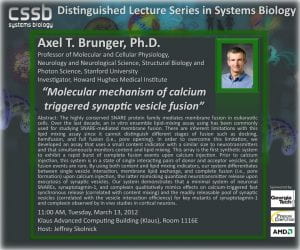 Distinguished Lecture Series Guest Speaker: Axel T. Brunger
Distinguished Lecture Series Guest Speaker: Axel T. Brunger
Professor of Molecular and Cellular Physiology, Neurology and Neurological Sciences, Structural Biology, and Photon Science
Stanford University
Investigator, Howard Hughes Medical Institute
Date & Time: Tuesday, March 13, 2012, 11:00AM
Location: Klaus 1116E
Host: Jeffrey Skolnick
Abstract: The highly conserved SNARE protein family mediates membrane fusion in eukaryotic cells. Over the last decade, an in vitro ensemble lipid-mixing assay using has been commonly used for studying SNARE-mediated membrane fusion. There are inherent limitations with this lipid mixing assay since it cannot distinguish different stages of fusion such as docking, hemifusion, and full fusion (i.e., pore opening). In order to overcome this limitation, we developed an assay that uses a small content indicator with a similar size to neurotransmitters and that simultaneously monitors content and lipid mixing. This array is the first synthetic system to exhibit a rapid burst of complete fusion events upon calcium injection. Prior to calcium injection, this system is in a state of single interacting pairs of donor and acceptor vesicles, and fusion events are rare. By using both content and lipid mixing indicators, our system differentiates between single vesicle interaction, membrane lipid exchange, and complete fusion (i.e., pore formation) upon calcium injection, the latter mimicking quantized neurotransmitter release upon exocytosis of synaptic vesicles. Our system demonstrates that a minimal system of neuronal SNAREs, synaptotagmin-1, and complexin qualitatively mimics effects on calcium-triggered fast synchronous release (correlated with content mixing) and the readily releasable pool of synaptic vesicles (correlated with the vesicle interaction efficiency) for key mutants of synaptotagmin-1 and complexin observed by in vivo studies in cortical neurons.
Additional Info: The goal of the Brunger lab is to understand the molecular mechanism of synaptic neurotransmission. They are interested in the structure, function, and dynamics of key players in the synaptic vesicle fusion machinery. Their lab is also working on the mechanism of action of clostridial neurotoxins that target this machinery. Other projects include protein complexes that are involved in synaptic development and the ATPases of the AAA family that are involved in protein complex disassembly and degradation. A molecular understanding of these complex protein machineries may ultimately lead to new therapeutics to treat human diseases.
Faculty Profile
Lab Website
HHMI Investigator Page
